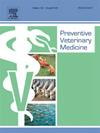Evaluating the effectiveness of badger vaccination combined with cattle test-and-removal in managing Bovine Tuberculosis: Insights from a two-host and multi-route transmission model
IF 2.2
2区 农林科学
Q1 VETERINARY SCIENCES
引用次数: 0
Abstract
Bovine tuberculosis (bTB) has a complex infection ecology and is difficult to control in many countries, including Ireland. For many years, the Irish national bTB eradication programme relied on cattle-based control measures, including test-and-removal with related movement restrictions. In the early 2000s, badger culling was added as a part of the control measure in the national programme. As badgers are protected animals under Wildlife Acts, making culling undesirable, this practice is now progressively being replaced by badger vaccination. However, it is unclear whether badger vaccination, in combination with the cattle test-and-removal and movement restriction, is sufficient to eradicate bTB, or whether additional measures will be needed. Assessing the impact of badger vaccination on reducing bTB in cattle is complex due to the involvement of multiple hosts and transmission routes. Key contributors include transmission to and from wildlife (e.g., European badger, Meles meles), the persistence of Mycobacterium bovis in the environment, and – due to imperfect diagnostic tests - the movement of infected cattle and residual infection in the herd. Understanding of relative contribution of these infectious sources is a key knowledge gap. This study aims to assess the impact of badger vaccination, in addition to cattle test-and-removal and movement restriction, on bTB eradication at a regional level and to assess whether additional interventions are needed. Additionally, we investigate the contribution of several transmission mechanisms such as, local cattle, residual infection, badgers and introduced cattle on the transmission of bTB at the level of both the individual and the herd. To achieve this, we developed a metapopulation model that includes each of the above-mentioned transmission mechanisms for the Kilkenny badger vaccination trial area. The model incorporates within-herd transmission for cattle and within-territory transmission for badgers, and also transmission between herds, both via cattle trade movements and via overlapping badger territories. Our results show that cattle-to-cattle transmission contributes most to new cattle infections at the individual animal (cattle) level, while breakdowns at the herd level usually involve multiple routes. Badger vaccination, when combined with cattle test-and-removal programme, may not be sufficient to achieve eradication in this region. We highlight the need for additional interventions that target cattle, badger, and movement to form a comprehensive intervention strategy, including cattle vaccination, improve farm biosecurity, badger vaccination and risk-based trading.
评估獾疫苗接种结合牛测试和去除在管理牛结核病方面的有效性:来自双宿主和多途径传播模型的见解
牛结核病(bTB)具有复杂的感染生态,在包括爱尔兰在内的许多国家难以控制。多年来,爱尔兰国家bTB根除规划依赖于以牛为基础的控制措施,包括检测和清除以及相关的移动限制。在21世纪初,獾被作为控制措施的一部分加入到国家计划中。由于獾是受《野生动物法》保护的动物,因此不希望捕杀獾,这种做法现在正逐渐被獾疫苗所取代。然而,目前尚不清楚獾疫苗接种,结合牛的检测和转移以及行动限制,是否足以根除bTB,或者是否需要额外的措施。由于涉及多个宿主和传播途径,评估獾疫苗接种对减少牛bTB的影响是复杂的。主要因素包括野生动物之间的传播(例如欧洲獾)、牛分枝杆菌在环境中的持续存在,以及(由于诊断测试不完善)受感染牛的移动和牛群中的残留感染。了解这些传染源的相对贡献是一个关键的知识缺口。这项研究的目的是评估獾疫苗接种以及牛的检测和清除和移动限制对在区域一级根除bTB的影响,并评估是否需要额外的干预措施。此外,我们还调查了几种传播机制,如本地牛、残留感染、獾和引进牛在个体和牛群水平上对bTB传播的贡献。为了实现这一目标,我们为基尔肯尼獾疫苗接种试验区开发了一个包含上述每种传播机制的元种群模型。该模型结合了牛的群内传播和獾的领地内传播,以及牛群之间的传播,这两种传播都是通过牛的交易运动和重叠的獾领地进行的。我们的研究结果表明,牛与牛之间的传播在单个动物(牛)水平上对牛的新感染贡献最大,而在牛群水平上的故障通常涉及多种途径。獾疫苗接种与牛的测试和移除计划相结合,可能不足以在该地区实现根除。我们强调需要针对牛、獾和运动采取额外的干预措施,以形成一项全面的干预战略,包括牛疫苗接种、改善农场生物安全、獾疫苗接种和基于风险的贸易。
本文章由计算机程序翻译,如有差异,请以英文原文为准。
求助全文
约1分钟内获得全文
求助全文
来源期刊

Preventive veterinary medicine
农林科学-兽医学
CiteScore
5.60
自引率
7.70%
发文量
184
审稿时长
3 months
期刊介绍:
Preventive Veterinary Medicine is one of the leading international resources for scientific reports on animal health programs and preventive veterinary medicine. The journal follows the guidelines for standardizing and strengthening the reporting of biomedical research which are available from the CONSORT, MOOSE, PRISMA, REFLECT, STARD, and STROBE statements. The journal focuses on:
Epidemiology of health events relevant to domestic and wild animals;
Economic impacts of epidemic and endemic animal and zoonotic diseases;
Latest methods and approaches in veterinary epidemiology;
Disease and infection control or eradication measures;
The "One Health" concept and the relationships between veterinary medicine, human health, animal-production systems, and the environment;
Development of new techniques in surveillance systems and diagnosis;
Evaluation and control of diseases in animal populations.
 求助内容:
求助内容: 应助结果提醒方式:
应助结果提醒方式:


